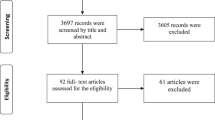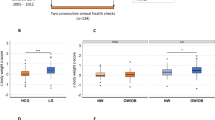Abstract
OBJECTIVE: Obesity in children impacts on their health in both the short and long term. Having an accurate and precise body composition assessment, it may be possible to control growth process and predict adult status in order to reduce the risk factors for various diseases.
METHOD: To review methods for body composition assessment that may provide new insights into the clinical practicality of paediatric obesity prevention/treatment. To present which specific outcome measurements in paediatric obesity prevention trials could be used to detect subjects at risk as early as possible.
RESULTS: We discussed body composition measurements that could be used in daily clinical practice and as outcome measurements in prevention trials.
CONCLUSION: These measurement procedures could be associated with methods for preventing obesity onset or retarding the weight gain associated with ageing.
This is a preview of subscription content, access via your institution
Access options
Subscribe to this journal
Receive 12 print issues and online access
$259.00 per year
only $21.58 per issue
Buy this article
- Purchase on Springer Link
- Instant access to full article PDF
Prices may be subject to local taxes which are calculated during checkout
Similar content being viewed by others
References
Higgins PB, Gower BA, Hunter GR, Goran MI . Defining health related obesity in prepubertal children. Obes Res 2001; 9: 233–240.
Keller KL, Pietrobelli A, Faith MS . Genetics of food intake and body composition: lessons from twin studies. Acta Diabetol 2003; 40: S95–S100.
Goran MI . Measurement issues related to studies of childhood obesity: assessment of body composition, body fat distribution, physical activity, and food intake. Pediatrics 1998; 101: 505–518.
Sopher A, Shen W, Pietrobelli A . Pediatric body composition methods. In: Heymsfield SB, Lohman T, Wang ZM, Going S (eds). Human Body Composition. Human Kinetics: Champaign, IL; 2005, in press.
Faith MS, Pietrobelli A, Allison DB, Heymsfield SB . Prevention of pediatric obesity. Examining the issues and forecasting research directions. In: Benedich A, Deckelbaum RJ (eds). Preventive Nutrition 1997. Humana Press: New York, 471–486.
Must A, Strauss RS . Risk and consequences of childhood and adolescent obesity. Int J Obes Relat Metab Disord 1999; 23: S2–S11.
World Health Organization. Obesity, preventing and managing the global epidemic: report of the WHO consultation of obesity. World Health Organization: Geneva; 1997.
Epstein LH, Myers MD, Raynor HA, Saelens BE . Treatment of pediatric obesity. Pediatrics 1998; 101: 554–570.
Wang ZM, Pierson Jr RN, Heymsfield SB . The five level model: a new approach to organizing body composition research. Am J Clin Nutr 1992; 56: 19–28.
Cole TJ, Bellizzi MC, Flegal KM, Dietz WH . Establishing a standard definition for child overweight and obesity worldwide: international survey. BMJ 2000; 320: 1240–1243.
Pietrobelli A, Faith M S, Allison DB, Gallagher D, Chiumello G, Heymsfield SB . Body mass index as a measure of adiposity among children and adolescents: a validation study. J Pediatr 1998; 132: 204–210.
Forbes GB (ed). Human body composition: growth, aging, and activity. Springer Verlag: New York; 1987.
Ellis KJ . Human body composition: in vivo methods. Physiol Rev 2000; 80: 649–680.
Rolland-Cachera MF . Prediction of adult body composition from infant and child measurements. In: Davies PWD, Cole TJ (eds). Body composition techniques in health and disease. Cambridge University Press: Cambridge; 1995. 100–145.
Chan JM, Rimm EB, Colditz GA, Stampfer MJ, Willett WC . Obesity, fat distribution, and weight gain as risk factors for clinical diabetes in men. Diabetes Care 1994; 17: 961–969.
Higgins PB, Gower BA, Hunter GR, Goran MI . Defining health-related obesity in prepubertal children. Obes Res 2001; 9: 233–240.
Pietrobelli A, Wang ZM, Heymsfield SB . Techniques used in measuring human body composition. Curr Opin Clin Nutr Metab Care 1998; 1: 439–448.
Van Loan MD . Is dual energy X-ray absorptiometry ready for prime time in the clinical evaluation of body composition? Am J Clin Nutr 1998; 68: 1155–1156.
Pietrobelli A, Formica C, Wang ZM, Heymsfield SB . Dual-energy X-ray absorptiometry body composition model: review of physical concepts. Am J Physiol 1996; 271: 941–951.
Pietrobelli A, Wang ZM, Formica C, Heymsfield SB . Dual-energy X-ray absorptiometry; fat estimation errors due to variation in soft tissue hydration. Am J Physiol 1998; 274: 808–816.
Campbell K, Waters E, O'Meara S, Kelly S, Summerbell C . Intervention for preventing obesity in children (Cochrane Review). In: The Cochrane Library, Issue 1 John Wiley & Sons, Ltd: Chichester, UK; 2004.
Dietz WH, Bellizzi MC (eds). Assessment of childhood and adolescent obesity. Am J Clin Nutr 1999; 70: S117–S175.
Wagner DR, Heyward VH . Techniques of body composition assessment: a review of laboratory field methods. Res Quart Exerc Sports 1999; 70: 135–149.
Author information
Authors and Affiliations
Corresponding author
Rights and permissions
About this article
Cite this article
Pietrobelli, A. Outcome measurements in paediatric obesity prevention trials. Int J Obes 28 (Suppl 3), S86–S89 (2004). https://doi.org/10.1038/sj.ijo.0802799
Published:
Issue Date:
DOI: https://doi.org/10.1038/sj.ijo.0802799
Keywords
This article is cited by
-
Cross-validation of bioelectrical impedance analysis for the assessment of body composition in a representative sample of 6- to 13-year-old children
European Journal of Clinical Nutrition (2009)
-
Adipose tissue and metabolic effects: new insight into measurements
International Journal of Obesity (2005)



